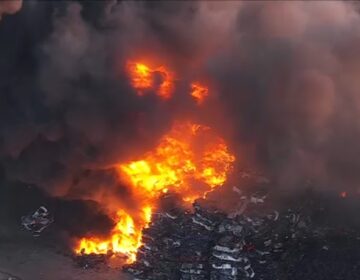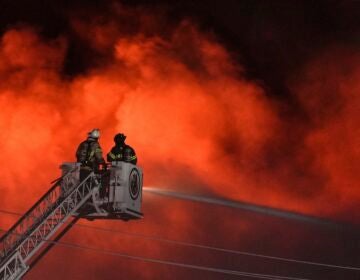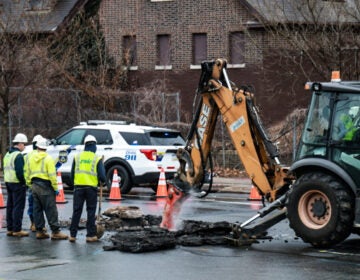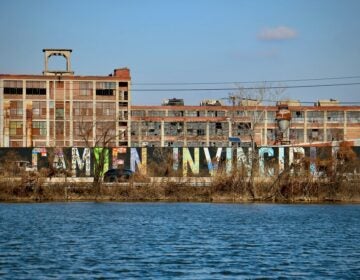‘It’s hellish now’: EMR fire leaves Camden residents worried about health and contamination
Neighbors reported difficulty breathing, headaches and lingering odors in the aftermath of the massive blaze.
From Camden and Cherry Hill to Trenton and the Jersey Shore, what about life in New Jersey do you want WHYY News to cover? Let us know.
Residents affected by the four-alarm fire at a metal recycler in South Camden a week and a half ago are still recovering from the experience.
“It’s hellish now, to live on this block and live in this neighborhood,” said Aliyia Jones, who lives with her mother and 19-year-old daughter less than 2,000 feet away from EMR’s fenceline.
A Camden County spokesperson said the fire was EMR’s sixth since 2016. Community members worry it won’t be the last.
They fear pollution from the frequent blazes will leave a lasting mark on the community’s health.
Residents affected by EMR fire struggle with respiratory ailments, headaches and sleep issues
When Jones returned to her house after the fire, she said she found a “horrible” smell and a brown discoloration on the napkins and mail sitting on her kitchen table. Her smoke detectors beeped continuously, even after she replaced the batteries. She worries the nebulizer machine she uses to treat her asthma is tainted.
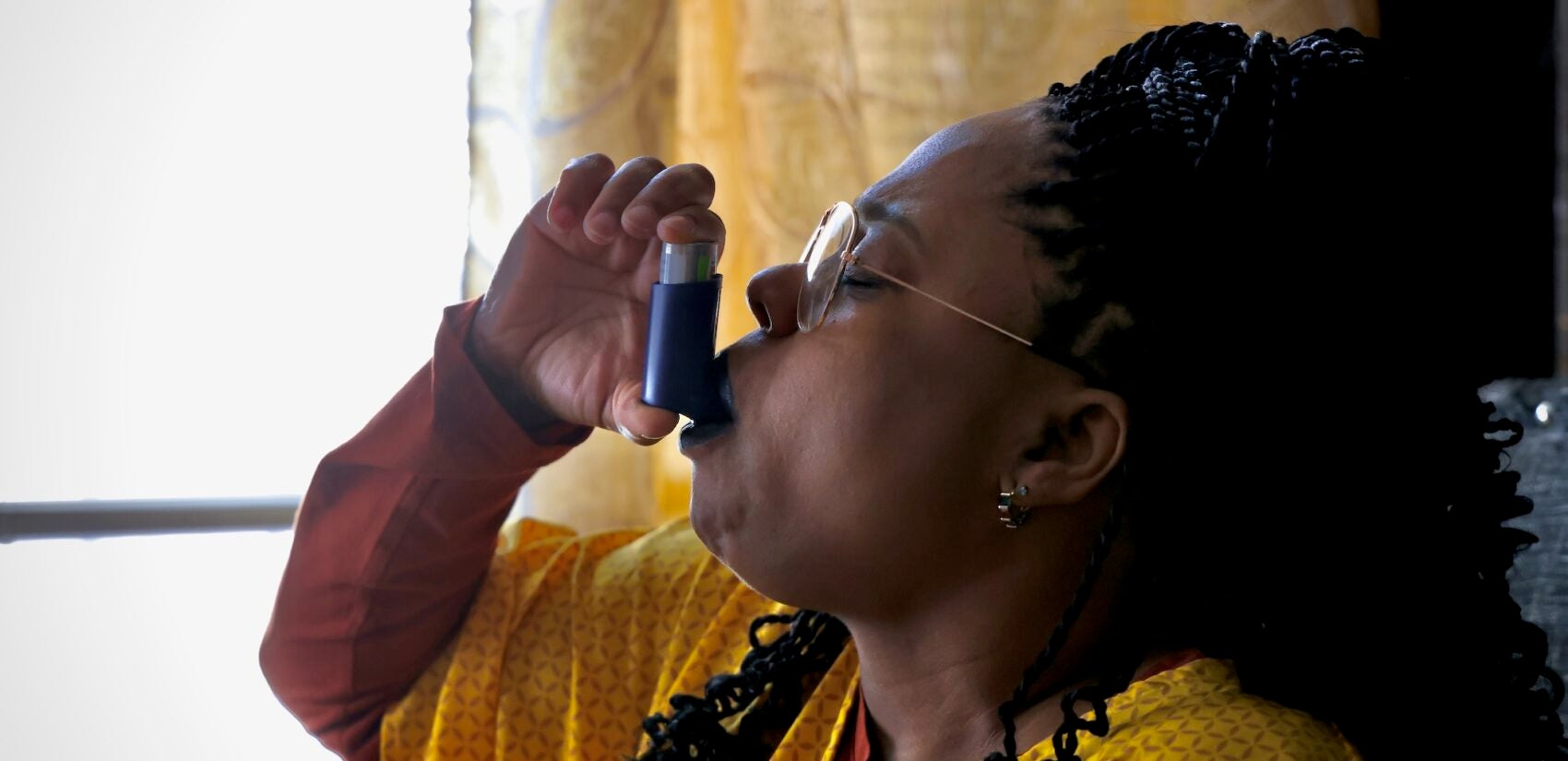
Jones, a direct support professional for people with disabilities, has not been able to work since the fire. She has also had trouble sleeping. Without an audible alarm in the neighborhood to alert residents in case there is another fire at EMR, she has felt the need to stay vigilant.
“I am that alarm,” Jones said. “I’m walking past [the window] every two, three hours to glimpse out and see if I see a cloud of smoke. And that’s horrible. It’s nightmares. When I do doze off, I’ve felt like I’m letting my family down by not being on guard.”

Christina Allen, who lives with her mother and 3-year-old son just around 1,500 feet away from the fenceline of EMR’s metal recycling complex, said the fire filled her home with a haze and a smoky smell.
The family evacuated for the weekend, but still, Allen’s young son developed a cough and congestion. Allen’s mother, who has chronic breathing problems resulting from a severe case of COVID-19, looked pale when she re-entered the house two days later, Allen said.
“She was kind of in a daze,” she said. “I had to tell her, ‘I think you need to sit down, put your oxygen on, because the air is really bad.’”

Allen said she herself experienced fatigue, headaches, coughs and a hoarse voice while traveling back and forth from the hotel to her home to check on her cat.
“I was being exposed to the air and all of the toxins that whole time,” she said. “It was like I was in a daze. Every time I went in the house, I would get really fatigued when I left. I just wanted to just sleep.”
Allen, who was pregnant when she evacuated during one of the company’s earlier fires in 2020, worries about long-term health impacts from the fires. She wants nearby residents to be provided with wellness checks and medical monitoring.
“So we’ll know in a couple of days if we’ll have issues with breathing, or even in a couple of years, if there’s something that we should be concerned about as far as our health,” she said.
Concerns about the safety of backyards, a park and a community garden
Two days after the fire, Timothy Heatwole Shenk was practicing soccer with his kids at Liney Ditch Park near EMR when they smelled a smoky odor in the grass. Heatwole Shenk, who is a teacher at Sacred Heart School near the park, said his students go there during recess.
“We had returned to the neighborhood, the smell had dissipated, the smoke was gone, the fire was out — and yet we were still smelling the fire in the grass,” Heatwole Shenk said. “And the concern is, what is the residual effects in terms of pollution and fallout from the fire?”
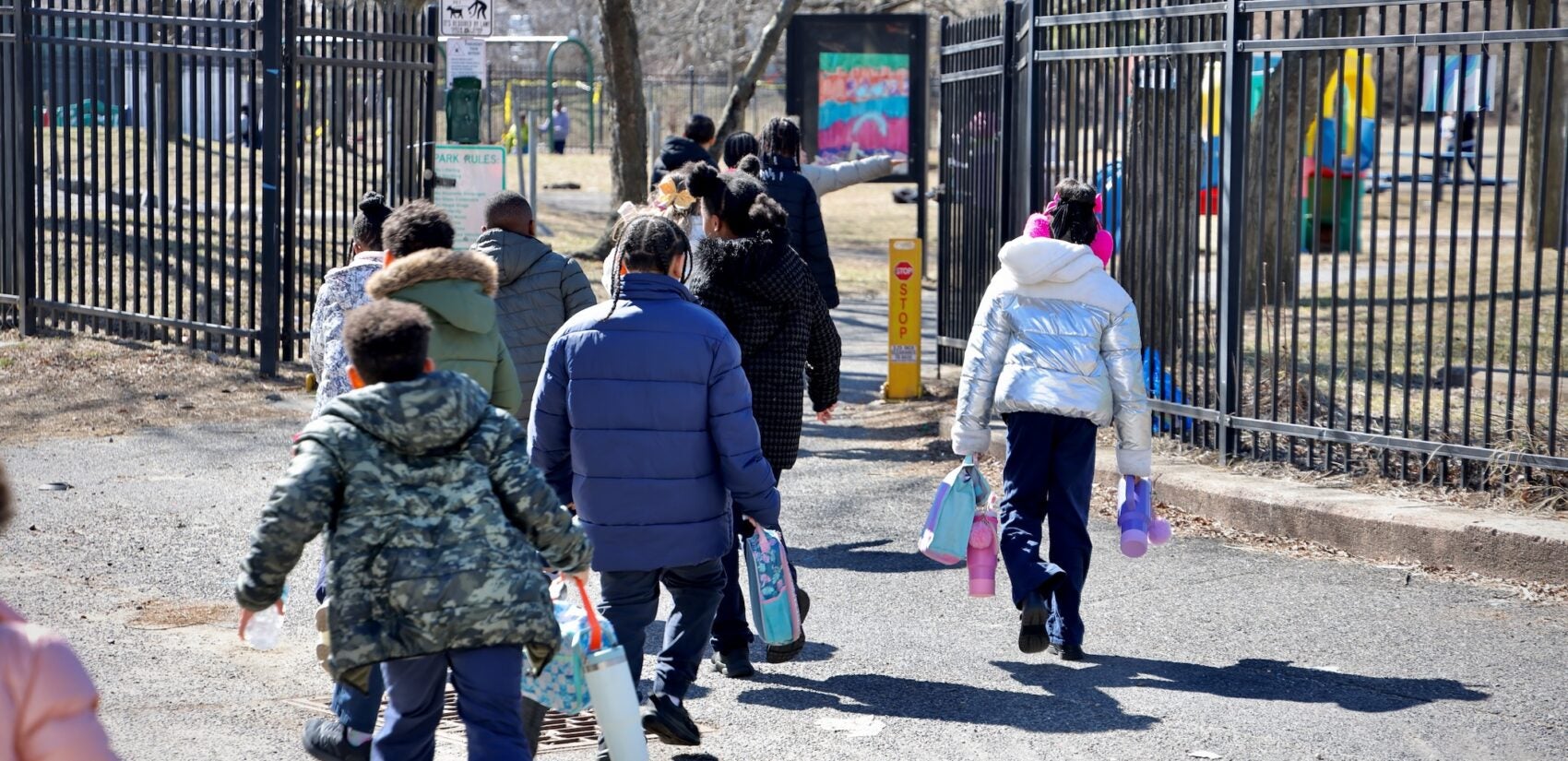
Heatwole Shenk also noticed a layer of black dust on the lid of a cooler in his family’s backyard, located roughly 1,800 feet from EMR’s fenceline.
“I might not have thought so much about the fallout and what happens days after, or weeks or years after, in terms of what’s in the soil,” he said. “Seeing that layer of soot and ash made me realize there’s more that is continuing to impact the neighborhood beyond the smoke itself.”

Allen said there was a white film of ash on the grass and furniture in her backyard.
“It’s just like covering basically everything,” she said Friday.
Staff at the nonprofit Center for Environmental Transformation worry contaminants from the fire could affect the soil in their community garden on Emerald Street.
“It’s a spot where we teach elementary school students that are putting their hands in the soil,” said garden educator Leslie Canales. “It’s important that they have healthy soil, that they don’t have to come back and be worried about what they were exposed to.”
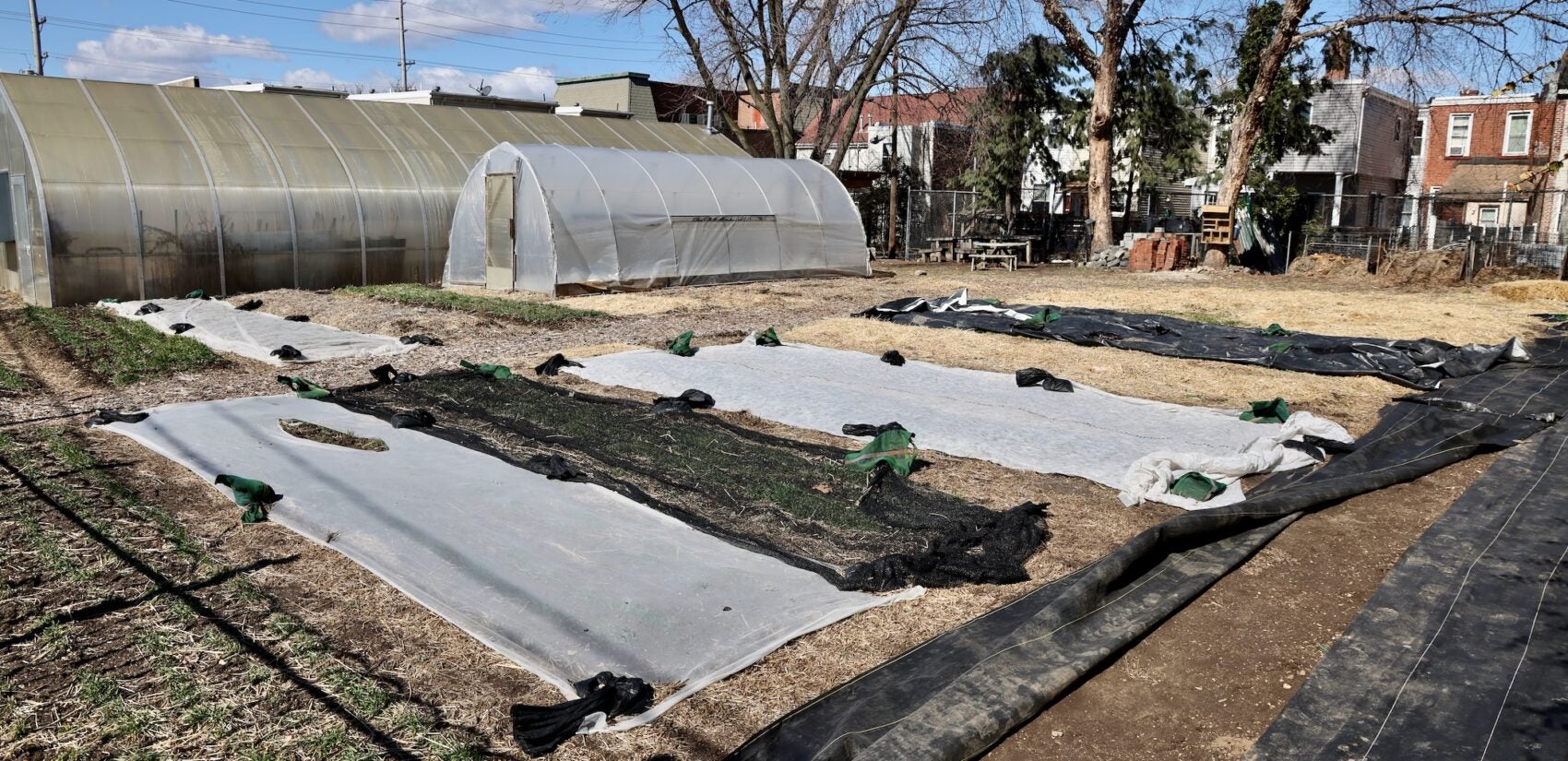
The soil tested free of lead and arsenic several years ago, said Jon Compton, the organization’s executive director. But the organization does not have the capacity to test for every single toxic substance.
“There’s a lot of unknowns in a fire like this,” he said. “What exactly are you supposed to do afterwards if you’re worried about soil contamination? … What should we be testing for?”
Experts say dust from industrial fires can be toxic
Smoke from industrial fires tends to consist of gases and airborne particles, said Kabindra Shakya, a professor at Villanova University who studies air and soil pollution. Toxic gases dissipate in the air fairly quickly, allowing levels to return to normal within hours or days. But heavier particles tend to settle.
“Eventually, they’re going to fall down onto the ground, the waterways, the soil,” Shakya said. “When they fall around these houses, like in the yards or in the community gardens, it stays there.”
Fine particulate pollution can be dangerous when it’s airborne. It can get deep inside lungs and even enter the bloodstream, worsening lung and heart conditions. The evening of the EMR fire, an air pollution monitor at the neighboring Camden County Municipal Utilities Authority documented fine particulates spiking into the unhealthy range.
Metals, such as copper and lead, or organic compounds, such as cancer-causing benzene, can also “hitch a ride” on these tiny particles, said Justin Richardson, a professor at the University of Virginia who studies soil pollution.
“Those particulates … could range in their toxicity from benign to very toxic,” Richardson said. “It’s really about the duration and exposure rate. So, if it’s a small amount over a short period, the toxicity is going to be less than long periods of exposure.”
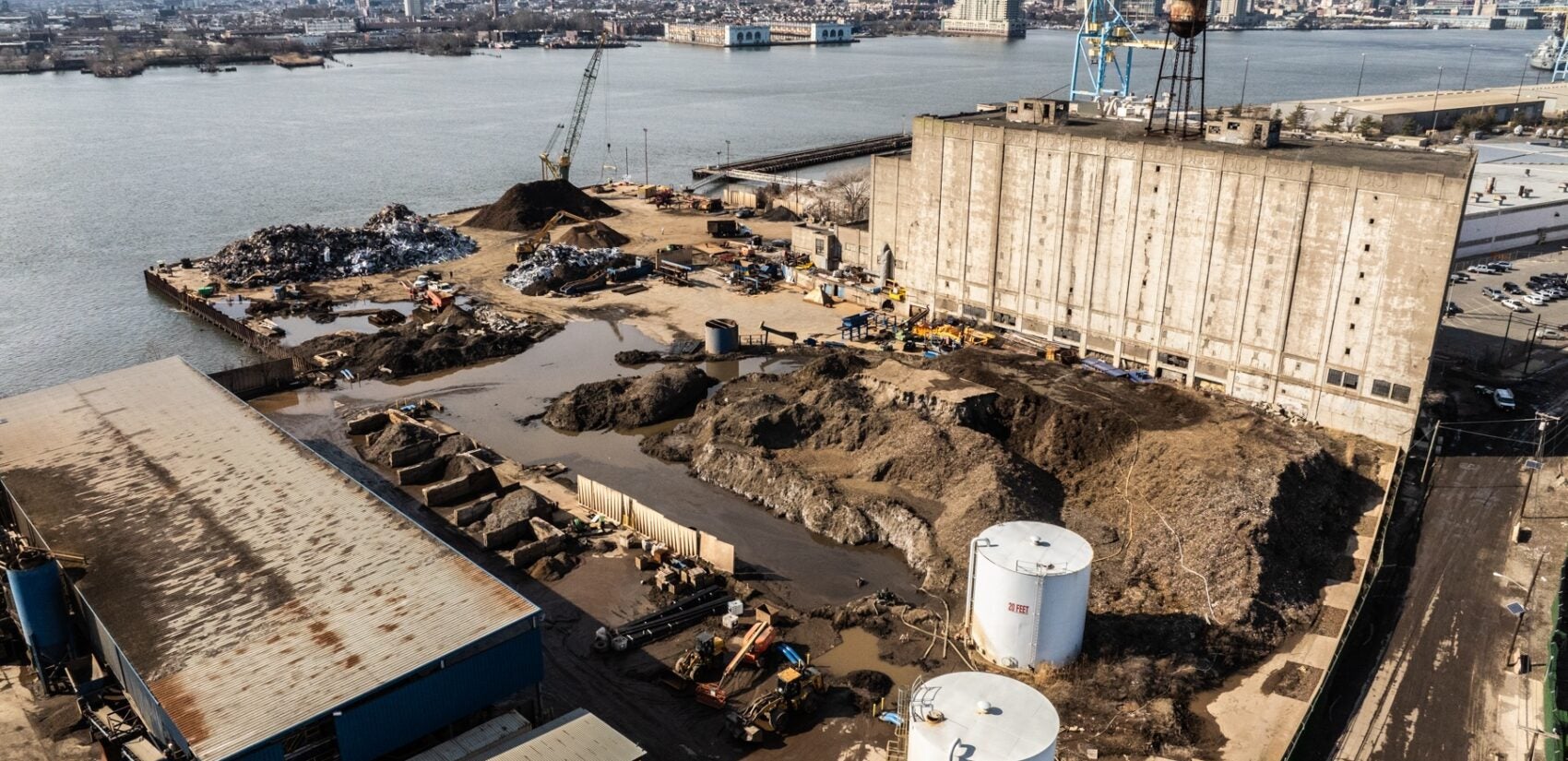
Richardson and Shakya said it’s hard to know what specific substances were carried by particles from the EMR fire without investigation. It’s also hard to specify how far the particles may have traveled and where they may have landed, although the closer a property is to the site of the fire, the more particles likely settled on it, said Marilyn Howarth, an adjunct professor of pharmacology at the University of Pennsylvania.
“All fires have carcinogens remaining in the particles left behind,” Howarth wrote in an email. “No one is likely to become acutely ill after putting their particulate-dirty hands in their mouth, but it’s always better to minimize ingestion of carcinogens.”
How to clean up ash or dust if you are affected by the EMR fire
Settled particulate pollution can travel into homes on shoes, clothing that’s been hung out to dry during a fire or other items brought in from outside, Shakya said. Young children are the most vulnerable because of their body size and because they crawl, touch their surroundings and put things in their mouths, Richardson said. Soil pollution can also affect food grown in the soil, particularly tubers like carrots or potatoes, he said.
Experts recommend washing any dust off porches, outdoor furniture, outdoor toys or play equipment and taking shoes off outside the home.
Children should not touch ash or help with cleanup work, and pregnant people or people with asthma, COPD or heart disease should be careful when handling ash or other debris, said Camden County spokesperson Dan Keashen. The county recommends wearing a tight-fitting respirator mask such as an N95, gloves and covering clothing when cleaning up ash, then changing those clothes afterwards. Use water to mist dusty areas before sweeping them, and avoid using leaf blowers or other cleanup methods that will send ash into the air.
The county recommends changing filters in HVAC systems or portable air purifiers, and having air ducts cleaned if they are clogged with “excessive amounts of dust and debris.” Residents of South Camden can dispose of ash in the garbage in double bags and call the Camden County Department of Health and Human Services for N95 masks at 856-374-6025, Keashen said.
‘How many fires does it take?’
After the latest fire, Waterfront South residents want change.
Christina Allen wants EMR to install pollution control devices to reduce the impact of fires on nearby families. She also wants to see residents provided with air filters, masks and health checkups for pets.
“I really would like them to just be more concerned about the residents,” Allen said. “If they’re going to still operate in our area and stuff, they need to take into consideration the residents’ health. … It just keeps happening, and it’s like we just get left to fend for ourselves.”
EMR did not respond to specific questions for this story, but sent WHYY a statement last week saying the fire was caused by a lithium-ion battery which was wrongly delivered to EMR. The company noted it provided over 100 hotel rooms and meals to nearby residents and called for regulation of lithium-ion batteries.
“We are angered that this happened and deeply regret any inconvenience to our neighbors,” the statement read. “The federal government and New Jersey Legislature must step in to ensure lithium-ion batteries do not pose any further risks to our communities. … While EMR takes multiple proactive measures to prevent these batteries from entering our recycling stream, the government must act immediately.”
Mike Morgan, a staff member at Heart of Camden, a nonprofit in Waterfront South that’s been collecting statements from neighbors about the impact of the fire, said some children no longer feel safe in their neighborhood. Residents want EMR to be held accountable for the harm it has caused. They are also demanding that EMR take actions to lower the risks the facility poses to homes and people’s health in the community, he said.
Aliyia Jones moved to Camden from Paulsboro — where a train derailed in 2012 and released cancer-causing gas. She felt she was protecting her daughters by leaving Paulsboro, but worries she brought them into another danger zone. Now, after witnessing several fires at the EMR facility, she wants to see the operation shut down. Barring that, she hopes to relocate again.

“How many chances and fines can you give one person?” she said. “How many fires does it take — ‘til you have casualties? It’s either them or me.”

Get daily updates from WHYY News!
WHYY is your source for fact-based, in-depth journalism and information. As a nonprofit organization, we rely on financial support from readers like you. Please give today.



